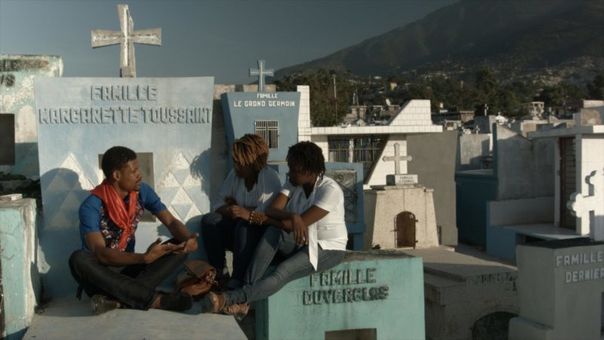To Open, To Haunt, To Excavate
A haunting, multi-sensorial experience, Ouvertures questions the (f)utility of language to dissect history and colonial heritage
by Adina Glickstein

© courtesy of The Living and the Dead Ensemble/Spectre Productions
Whispering, glowing, grazing, flashing, dripping. Gentle, vibratory evocations of phantom presence—the camera caresses the cave’s organic architecture, running over rock like the hand that dips into and out of the frame. “This is the work of Memory.” Eternal exteriors: snowscape, cavern, waterfall. Luxurious long fades graft us out of nature and into the world of the rendered, the strange: the landscape morphs, warping into one of digital genesis, the solidity of an evaporated history melting and cascading into data. So goes the overture to Ouvertures, a film produced collaboratively—following the model of free jazz—by The Living and The Dead Ensemble.
Presented as a progression of distinct movements, the film follows the Ensemble as they prepare a Creolized adaptation of Edouard Glissant’s Monsieur Touissaint. Glissant’s play—first written for the radio in 1959—tells the story of Touissant Louverture, a general who escaped enslavement to lead the victorious Haitian Revolution, but tragically never lived to see his country adopt its Constitution as the first free Black state in the Americas in 1804. Arrested by Napoleon’s Army as they attempted to crush the colonial uprising, Louverture perished in exile: extradited by the colonists to the Jura Mountains, he died imprisoned in the frost-bound Alps.
The Ensemble’s debates over translation and performance, which serve as the film’s narrative quantum, act as a microcosm of the broader questions of postcolonial self-styling that linger in the unresolved questions of Louverture’s story. Ensemble members tease out the vestiges of colonial power embedded in Glissant’s play, turning a critical eye on the past to interrogate the utility—and, more often, futility—of language in conjuring the troubling thickness of history. In one moment, the camera lingers behind two troupe members as they lament the omission of women in Glissant’s work; in another, actors transmute the play’s energy into an exchange of freestyle raps. Among the questions that arise in their investigation: what is the utility of leading with one’s heritage, of taking it up as an affirmation in a world that, just as in Glissant and Louvertures’ before ours, seeks to minimize and violate blackness?
Formally, the credited directors’ presence is unobtrusive. The film’s editing and structure arrange, but decline to interject or comment on, the Ensemble’s meandering exercises. Following from Trinh T. Minh-Ha’s directive for documentary “not to speak about, but to speak nearby,” Ouvertures goes one step further—often, not to speak at all. Here, the film’s enigmatic opening is decisive: spacious and sparsely-worded, it lingers on Jura’s surface textures, probing for a material trace of Louverture’s embodied existence. In moments like these, it communicates through affect what language leaves unsaid. “It’s a form of poetic writing that we can’t translate literally,” argues one performer as the Ensemble works over Glissant’s text. The same refrain holds true for the film itself: engaging full sensory spectrum, it brushes up against the outer extremes of meaning, suggesting that the most radical openness toward justice—expansive, inclusive, decolonized—lies at the margins of signification.

